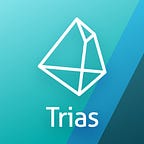To the Trias Community:
The NetX ecosystem has officially set sail! To mark the beginning of a new milestone in the ecosystem,the NetX mainnet token migration plan will officially start on April 29, 2024, at 10:00 AM (UTC).This initial migration will include 1.5 million ERC20 tokens and 1 million BSC tokens, for a total of 2.5 million Trias tokens to be migrated to the mainnet.
Migration Process:
- Visit the Trias website: https://www.trias.one/
- From “NetX” click on “Migrate TRIAS”
- Connect your wallet and select the network you want to migrate from (ETH or BSC)
- Enter the amount of tokens you want to migrate
❗️Important Notes:
- This migration is a one-way operation and cannot be reversed at this time. Therefore, please be sure to confirm the amount you wish to migrate.
- TEP20 TRIAS tokens are expected to be launched in May, at which time you will be able to claim your migrated TEP20 TRIAS tokens.
NetX Ecosystem Highlights in May
We will enter May with unstoppable momentum:
Launch Public Testnet, Activate Faucets:
Along with the first phase of mainnet token migration, we will launch the public testnet in May and open it up to community members for comprehensive stress testing. At that time, the faucets will be activated, and we invite community members to participate actively.
After a period of stress testing, we will combine the test data to upgrade the mainnet and officially distribute mainnet tokens to users who have participated in the token migration at the end of May. Users who participate in the mainnet token migration will receive an airdrop of TAS tokens, which will be used to pay for GAS fees on the mainnet.
Once you receive your mainnet tokens, you will not be able to trade them immediately, as we are still actively working on arranging exchange listings for it. We ask you to be patient as we are looking to finalise listings for the new mainnet token in the coming months.
NetX Cross-chain Bridge Goes Live, ERC20/BEP20 Tokens and TEP20 Support Bi-directional bridge:
Considering that public testing will be conducted throughout May and there may also be external uncertainties. We will launch the bi-directional bridge in May, and ERC20/BEP20 tokens and TEP20 will support bi-directional bridging. Users who have already bridged to the mainnet can bridge back to the source chain at any time through the bridge if they do not want to keep their tokens on the mainnet for any reason.
* This is an early reminder that if you migrated to TEP20 via BEP20, you will only be able to bridge TEP20 to BEP20 when you want to bridge back to the source chain.
Ecosystem Capabilities Converge on Mainnet:
With the launch of the first phase of mainnet token migration, the core capabilities of all sub-ecosystem projects will begin to converge on the mainnet. These include Triathon AI and the ability of humans to co-evolve; Tusima’s ability to connect users to entity behavior; and Leviatom’s ability to launch a decentralized service network. These core capabilities will all converge on the ecosystem mainnet.
* In the future, we look forward to adding multiple functionalities / utility to $TRIAS on the Mainnet. This will include:
- $TRIAS being the sole method to obtain $TAS in the NetX ecosystem, the Mainnet’s GAS token.
- $TRIAS holders will also be able to participate in airdrop / staking campaigns to obtain the ecosystem tokens.
- Trias Lab reserves the right to modify above information based on actual environmental conditions or unforeseen circumstances prior to the actual occurrence of the event. We will make every effort to notify all participants of any changes and minimize the impact on the event.
The launch of the NetX Migration Plan marks a new chapter for the NetX ecosystem. We will continue to strive to provide the community with a safer, more efficient, and more convenient blockchain experience.
Thank you for your support!
The Trias Team
28th April 2024
🔹Official website: https://www.trias.one
🔹Whitepaper: https://www.trias.one/whitepaper
🔹Twitter: https://twitter.com/triaslab
🔹Twitter: https://twitter.com/Trias_One
🔹Telegram: https://t.me/triaslab
🔗All official links: https://linktr.ee/triaslab
